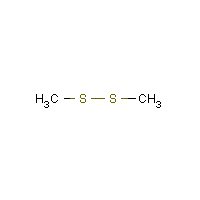Dimethyl disulfide
Agent Name
Dimethyl disulfide
CAS Number
624-92-0
Formula
C2-H6-S2
Major Category
Other Classes

Synonyms
2,3-Dithiabutane; Dimethyldisulfide; Disulfide, dimethyl; DMDS; Methyl disulfide; Methyldisulfide; Methyldithiomethane; Paladin; Dimethyl disulphide; [ChemIDplus] MDS; Methyl disulphide; [CHEMINFO] (Methyldithio)methane; Sulfa-Hitech; [CAMEO] Dimethyldisulfid; Disulfuro de dimetilo; Disulfure de dimethyle; [ECHA REACH Registrations] UN2381
Category
Sulfur Compounds
Description
Colorless, oily liquid with a garlic-like odor; [CAMEO] Strong, nauseating odor; [CHEMINFO] Clear light yellow liquid with a stench; [Sigma-Aldrich MSDS]
Sources/Uses
Used as a chemical intermediate: [CAMEO] Released in Kraft pulping to make paper; Also used as a "gas well down hole process aid"; Proposed to replace methyl mercaptan as a jet fuel additive; [NTP] Occupational exposure also occurs at sewage treatment plants. It occurs naturally in many foods. [HSDB] Also used as a sulfiding agent in refineries, a solvent for sulfur, to reduce coke deposits in the petrochemical industry, an artificial flavoring agent, and a corrosion inhibitor; [CHEMINFO] Used to flavor animal feeds; [EFSA - FEEDAP] Used as a flavoring agent; [FDA]
Comments
A mild skin irritant, dimethyl disulfide is toxic by inhalation, skin absorption, and ingestion. Workers are warned by the nauseating odor, but those exposed to high concentrations may experience fatigue, dyspnea, and upper respiratory tract irritation. At lethal concentrations, animals suffer severe lung injury and paralysis of respiratory muscles. [CHEMINFO] Showed weak to moderate sensitizing potential in local lymph node assay (LLNA) of mice; [EPA - TSCATS] An eye, respiratory tract, and mild skin irritant; May cause CNS effects; [ICSC] Safe when used as a flavoring agent in food; [JECFA] A strong eye irritant; Harmful by ingestion; Toxic by inhalation; [Sigma-Aldrich MSDS]
Biomedical References
Exposure Assessment
Skin Designation (ACGIH)
Yes
TLV (ACGIH)
0.5 ppm
Vapor Pressure
28.7 mm Hg
Odor Threshold Low
0.00078 ppm
Odor Threshold High
0.0036 ppm
Lethal Concentration
LC50 (rat) = 15.85 mg/m3/2hr
Explanatory Notes
Odor threshold (detection) from CHEMINFO; VP from ChemIDplus;
ERPG-1
0.01 ppm
ERPG-2
50 ppm
ERPG-3
250 ppm
Adverse Effects
Toxic Pneumonitis
Yes
Neurotoxin
Other CNS neurotoxin
Diseases, Processes, and Activities Linked to This Agent
Diseases
Occupational diseases associated with exposure to this agent:
Processes
Industrial Processes with risk of exposure: